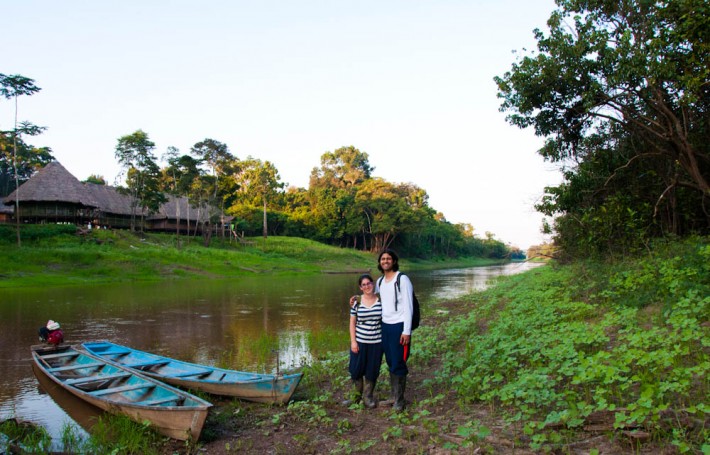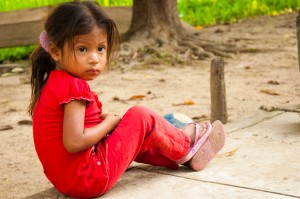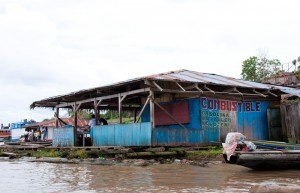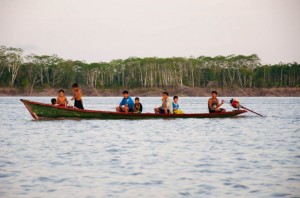The beauty of traveling in Peru is that, within the same country, there are such diverse areas as the coast, the highlands (Andes) and the jungle (Amazon).
Until last year, whenever I’d think of the Amazon, I’d immediately picture a region within Brazil. Although it is true that the vast majority of the Amazonian land lies inside Brazil, it is also a reality that it extends to others countries such as Ecuador, Bolivia, Colombia, Venezuela, Guyana, Suriname, French Guiana and Peru. In fact, following Brazil, Peru is home to the 2nd largest portion of Amazon (13%) and this jungle makes up for more than half the Peruvian territory!
Although we did a brief rain forest trip in Ecuador, departing from Puyo, we didn’t really have the whole “Amazon experience” until we went to Peru. We joined the guys at Amazonian Trips - Chullachaqui Eco Lodge and, with them, spent 3 days and 2 nights deep into the jungle.
There are essentially 2 ways to get into the Peruvian side of the Amazon: either you navigate the rivers by boat or you fly into the jungle city of Iquitos. Iquitos is only accessible by flight because it is really surrounded by proper dense jungle.
Once in Iquitos (less than 1-hour flight from Lima), one must take a boat up the Amazon River to reach eco-lodges that have sprung out in the “middle of nowhere”. This lodges cater to tourists wishing to visit the rainforest, but perhaps not adventurous enough to just go into the wild on expeditions without a proper base camp. For us, staying at Chullachaqui Eco Lodge was the best of both worlds: we got to be deep into the jungle and, at the same time, still enjoy some comforts like hot food, a bed, a bathroom and, of course, human touch.
Under the name “Tarantula Program”, our stay sure had to be filled with wild things!
Day 1
The morning of day 1 was spent catching a boat in Iquitos towards our lodge. The moment you leave the company of other tourist and mostly commercial boats, it hits you:
“WOW, I’m in the Amazon!”
The landscape you see is pretty much the greenery, wilderness, and exoticism that one expects after seeing photos and movies.
After about 1 hour up river though, we made a first stop that contradicted any preconceived ideas we might have had of the Amazon jungle. We stopped at what the locals call the “distrito“, the main town that serves as a sort of capital of other Amazonian villages, all scattered in the radius of Kms and Kms.
This town was extremely surprising for us: pavement, electricity, amenities, services, mobile phone connection… where we still in the middle of the Amazon? Yes, we were, but I guess times have changed and even the Amazonian towns are keeping up with the call for modernity. In any case, we still had one more hour of boat ride ahead, where a more rustic (and expected) side of the jungle awaited us.
We were traveling in a speedboat and to properly arrive at Chullachaqui Eco Lodge we had to be transferred into a canoe, where the Amazon river meets a little subsidiary that would go all the way to our new Amazonian home. We thought we would have to walk there, but fortunatel, we could enjoy this scenic ride in an extremely calm river surrounded by luscious vegetation: but they told us that just a few days back, due to the drought, the river didn’t have enough water to keep the canoe afloat.

Transfering from the speed boat into a canoe, where the Amazon river meets it's subsidiary, the Tapira river.
Once at the lodge, we met Lobo (the Spanish word for “Wolf”) our very own Amazonian guide. And the cool thing was that, during that first day, Ashray and I were the only 2 travelers around, having Lobo all for ourselves! He was eager to start exploring and showing us around. Before lunch itself, he took us on a short walk in the area surrounding our lodge, where we got an intro to the local flora, fauna and way of life. Lobo was born and raised in a village walking distance from the lodge: we could be certain that he knew what he was talking about!

Giant mushrooms spotted during a walk in the rain forest. The one on the right looks like Mickey Mouse!
A local person with knowledge + traveler’s curiosity are the perfect combination for long talks and Q&A sessions that can range from subjects such as food, money, love to drugs.
Lobo clarified the concept of “Ayahuasca” for us. We had read that it is rather common for people visiting the Amazon to try ‘Ayahuasca”, a plant concoction that induces into hallucinogenic effects. It doesn’t come as a surprise to me that Western tourists are into trying all these “natural drugs”. But what I did not expect was that this drug and ritual would be so common for indigenous Amazonian people. Taking Ayahuasca is actually a part of a religious sacrament that most Amazonian men go through.
Apart from the physical effects caused by drinking this mix (let’s just put it in a nice way and call it “internal body cleansing”), the psychedelic effects are the highlight. According to Lobo, most people will do it to find their path in life. As you hallucinate under the effects of Ayahuasca and connect with a spiritual world beyond Earth, you are supposed to see your future and, over all, get some guidance in life.
With plenty of conversation material after the walk, we headed back to the lodge to enjoy a nice lunch prepared by the in-house cook. Everyday, she presented us with a mix of Amazonian flavors along with elements that our palates would recognize and be comfortable about. Fish, chicken, beef and rice were served along shredded palm hearts (a totally different taste from the canned ones!), yuca (aka cassava, a root vegetable prepared as if potatoes) or camu-camu juice (an endangered fruit endemic to the Amazon).

Lunch at Chullachaqui Eco Lodge: chicken, rice, salad with local palm hearts and fried yuca. To drink: camu camu juice.
Although you get to do a lot as a traveler in a regular day at an Amazonian lodge, time also passes by slowly. After all there are no distractions that would take you away from making the most of the surrounding scenery: no internet, no electricity and up until recently, no phone signal. Now there is enough signal (in some particular spots) to make a call if need be. It’s worth mentioning that, although you dine with candle light, the lodge does have a generator that can be used to recharge batteries of cameras and other “first necessities”.
This slow pace made it possible for us to nap everyday after lunch and before heading onto the next activity!
The afternoon of the first day was reserved for a boat ride along the Amazon River, with the intention of spotting grey and pink dolphins. Although dolphins don’t normally have a shy behavior, we only managed to grasp the view of some of these fresh water creatures between splash and splash!
Pink dolphins are a symbol of the Amazon and appear commonly as elements in local traditions and sayings. One of the local myths says that at night, the “encantado” (enchanted) dolphin becomes an attractive man that makes love to local girls leaving them pregnant, returning afterwards to the water. I’m not sure if families of unmarried girls who suddenly become pregnant are going to find this very convincing!..
As enjoyable as it was to paddle around trying to spot the dolphins, I confess that the most beautiful part of it all was to just appreciate the serene landscapes and observe the Amazonian people trying to make a living. It has to eb mentioned that not all indigenous people are living by the ancient tribal ways one sees in National Geographic. There are indeed some tribes living in even deeper and more secluded areas of the jungle and perhaps with very reduced contact with outsiders (and by outsiders I mean others out of their own community, not just foreigners). But those in the villages near by our base camp were pretty regular looking Peruvians, that make a living mostly from fishing: they catch fish to eat and feed their families and also sell in the market in Iquitos. For this, they have to travel several hours by boat to the city, but there is even a “shuttle boat” for this. It is sort of a floating “bus” that goes up and down the river at least once a day in each direction, transporting villagers not only from the jungle into the city, but almost between villages. You’d be surprise of how well organized this place is!
To roam around the Amazon River, we used a motor powered canoe. We made good use of the speed to reach the main river from our lodge, but once in the area, switched to paddling, not to scare the dolphins away. It turns out that we started running short on fuel and luckily, as there were many other boats around, we could buy some petrol from a friendly fisherman that was having an exceptional day!

These fishermen were having a lucky day. And we also got lucky when they agreed to sell us some petrol!
After enjoying a glorious sunset floating in the Amazon River, we returned to the lodge to recharge batteries and only came out again after dinner. We did so for another boat ride, this time in the little river right in front of our lodge. The goal? To spot crocodiles! But we didn’t actually see any. When you plan your activities around nature, you can never be sure that things are going to go according to plan – and this is what makes everything exciting. Going to the Amazon is not like going to a Zoo. You might be able to see a lot, or not, but you’ll always get to experience a great deal!
For instance, in this situation, we didn’t see any crocodiles (we were trying to spot them by looking at shiny eyes just above the water) but we saw, from the first row, how locals catch fish. As we had seen earlier in the day by the fisherman’s catch, the river was unusually full of fish – I guess this might have to do with currents. So even our little river had thousands of little fish jumping around and, miscalculating their moves, landing inside our canoe. We had to rescue a bunch of them, while many others became Lobo’s family meals for the next day. He had absolutely no interest in the little ones, but instead captured at least 5 pieces of chunky fish “for breakfast”, to be served with bananas. It was quite an experience to observe this fishing session. There was no net or rod involved, but there was indeed a lot of precision and practice. Step number 1: you see a fish in the water. Then, you take your machete and hit it brutally in the head. And you finalize by taking the creature inside your canoe and hit it a couple of times more to end it all.
And this is how our first day in the Amazon ended.
But there was more! And if you want to find out, just like one should do into the wild, keep all your senses awake… be in a vigilant state, so you don’t miss a thing!
Click here for more stories, photos and a video of A&Z in the Amazon.
Book your stay in the Peruvian Amazon!


More info:
Amazonian Trips – Chullachaqui Eco Lodge
www.amazoniantrips.com
inforeservas@amazoniantrips.com
Raimondi 138, Iquitos – Peru
Phone: +51 65 225569
Packages start at around USD70 per person, per day: including accommodation in double room with private bathroom, all meals, activities and transportation.



















Pingback: A Window in the Jungle | Backpack Me
soooooooo cool!!! i want to go to the amazon too!
Pingback: Into the Wild! Our Amazon Trip: Part 2/2 | Backpack Me
Pingback: A, Bee & Z | Backpack Me
cool photos and write-up!
Here are my recent adventures in the Amazon, hopefully it inspires people to go for eco-tourism and helps preserve the jungle! … huge trees of the Tombopato Reserve and … the macaw clay-lick on the Tombopato River of Peru hope it might help!
Your trip looks amazing! Working in an events promotion company in London I have attended many travel events and lot of them were about the amazonia and what I saw and heard there made me want to go there. Your article too!
Thomas @ jorlio.com
Hey guys, good post, congrats!
You went to Iquitos but you don’t mention another Peruvian town surrounded by the jungle: Tarapoto.
Sure, considering its location, Iquitos is a unique base to visit the Amazon. As for me, I much preferred Tarapoto, it’s not so much taken over by tourism, much more authentic (and considerably cheaper too!). Also, the jungle of Tarapoto is mountainous, when the one around Iquitos is flat. Try it out next time you travel over there!
I want to visit Peru. Becauae its Nature is i like.